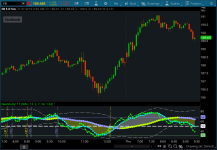The Traders Dynamic Index (TDI) is for assessing market conditions and forecasting price movements. It amalgamates trend analysis, momentum, and volatility components to offer a holistic perspective of the market.
The Traders Dynamic Index (TDI) is a plot to 2 smoothed RSIs on a overbought / oversold grid with a Bollinger Band (with mid-line) of unsmoothed RSI.
The basics are that a signal occurs when the less-smoothed RSI line crosses the more-smoothed RSI line. Reversals are possible near overbought / oversold values, especially near the edges of the Bollinger Band.

Credit:
The Traders Dynamic Index (TDI) is a plot to 2 smoothed RSIs on a overbought / oversold grid with a Bollinger Band (with mid-line) of unsmoothed RSI.
The basics are that a signal occurs when the less-smoothed RSI line crosses the more-smoothed RSI line. Reversals are possible near overbought / oversold values, especially near the edges of the Bollinger Band.
thinkScript Code
Code:
# LS_TradersDynamIcIndex_long
# Traders Dynamic Index
# 2 smoothed RSIs Plotted on OverBought / OverSold Grid
# with Bollinger Band of unsmoothed RSIs
declare lower;
input averageType = {default SMA, EMA};
# RSI (Relative Strength Index)====================
input Period = 13;
def RegRSI = reference RSI(Period);
# Compute 2 smoothed (by averaging) RSIs------------------
# 2 Smoothers--------------------------------------------------------
input sm1 = 2; # 1st RSI smoother
input sm2 = 7; # 2nd RSI smoother
# 1st smoothed RSI--------------------------------------------------
# Either ----------------------------------------------------------------
# (1) a simple averaging (SMA) or -------------------------
# (2) an exponential averaging (EMA)---------------------
def smRSI1 = if averageType == averageType.SMA then Average(RegRSI, sm1 ) else ExpAverage(RegRSI, sm1);
# 2nd smoothed RSI------------------------------------------------
# Either ---------------------------------------------------------------
# (1) a simple averaging (SMA) or ---------------------
# (2) an exponential averaging (EMA)-----------------
def smRSI2 = if averageType == averageType.SMA then Average(RegRSI, sm2) else ExpAverage(RegRSI, sm2);
# So far we have:
# 1. RegRSI = RSI
# 2. smRSI1 = 1st smoothed RSI, smoother = 2
# 3. smRSI2 = 2nd smoothed RSI, smoother = 7
#--------------------------------------------------------------------------
# PLOTS---------------------------------------------------------------
#---------------------------------------------------------------------------
# RSI1---1st smoothed RSI----------------------------------------
plot RSI1 = smRSI1;
RSI1.SetDefaultColor(Color.GREEN);
RSI1.SetLineWeight(2);
RSI1.SetStyle(Curve.FIRM);
RSI1.SetPaintingStrategy(PaintingStrategy.LINE_VS_POINTS);
RSI1.HideBubble();
RSI1.HideTitle();
# RSI2---2nd smoothed RSI---------------------------------------
plot RSI2 = smRSI2;
RSI2.SetDefaultColor(Color.CYAN);
RSI2.SetLineWeight(2);
RSI2.SetStyle(Curve.FIRM);
RSI2.SetPaintingStrategy(PaintingStrategy.LINE_VS_POINTS);
RSI2.HideBubble();
RSI2.HideTitle();
#============================================
# Bollinger Bands of RSI=========================
#============================================
# Length of Bollinger Averaging---------------------------------
input BBlength = 34;
# Width of Bollinger Band in Standard Deviations----------
input BBsdMult = 1.62;
# Mid-line for the Bollinger Band of the RegRSIs -----------
plot BBmidline = Average(RegRSI, BBlength);
BBmidline.SetDefaultColor(Color.CYAN);
BBmidline.SetLineWeight(5);
BBmidline.SetPaintingStrategy(PaintingStrategy.LINE_VS_POINTS);
BBmidline.SetStyle(Curve.FIRM);
BBmidline.HideBubble();
BBmidline.HideTitle();
BBmidline.AssignValueColor(if BBmidline < BBmidline [1] then Color.VIOLET else (if BBmidline == BBmidline [1] then Color.LIME else Color.LIME));
#--------------------------------------------------------------------------
# Upper and Lower Bollinger Bands---------------------------
#---------------------------------------------------------------------------
# Standard Deviation of unsmoothed RSIs-------------------
def SDBB = StDev(RegRSI, BBlength);
# Upper Line of Bollinger Band----------------------------------
plot uBBline = BBmidline + BBsdMult * SDBB;
uBBline.SetDefaultColor(Color.WHITE);
uBBline.SetStyle(Curve.LONG_DASH);
uBBline.SetLineWeight(1);
uBBline.HideBubble();
uBBline.HideTitle();
# Lower Line of Bollinger Band---------------------------------
plot lBBline = BBmidline - BBsdMult * SDBB;
lBBline.SetDefaultColor(Color.WHITE);
lBBline.SetStyle(Curve.LONG_DASH);
lBBline.SetLineWeight(1);
lBBline.HideBubble();
lBBline.HideTitle();
#--------------------------------------------------------------------------
# GRID-----------------------------------------------------------------
#--------------------------------------------------------------------------
plot OB = 68; # OverBought
plot ML = 50; # Mid-Line
plot OS = 32; # OverSold
OB.SetStyle(Curve.FIRM);
OB.SetDefaultColor(Color.VIOLET);
OB.SetLineWeight(1);
#OB.HideBubble();
OB.HideTitle();
ML.SetStyle(Curve.LONG_DASH);
ML.SetDefaultColor(Color.WHITE);
ML.SetLineWeight(3);
#ML.HideBubble();
ML.HideTitle();
OS.SetStyle(Curve.FIRM);
OS.SetDefaultColor(Color.LIGHT_GREEN);
OS.SetLineWeight(1);
#OS.HideBubble();
OS.HideTitle();
#---------------------------------------------------------------------------
# Add Vertical Line when RSI1 crosses BBmidline-----------
#---------------------------------------------------------------------------
AddVerticalLine (if RSI1 > BBmidline and RSI1[1] <= BBmidline
then 1 else 0, "--- UP ? ---", Color.YELLOW, Curve.LONG_DASH);
AddVerticalLine (if RSI1 < BBmidline and RSI1[1] >= BBmidline
then 1 else 0, "--- DN ? ---", Color.VIOLET, Curve.LONG_DASH);
#---------------------------------------------------------------------------
# Cloud between RSI2 and BBmidline-------------------------
#---------------------------------------------------------------------------
AddCloud (RSI2, BBmidline, Color.WHITE, Color.YELLOW);
# END ======================================Shareable Link
https://tos.mx/xfUH6XlCredit:
Attachments
Last edited by a moderator:

